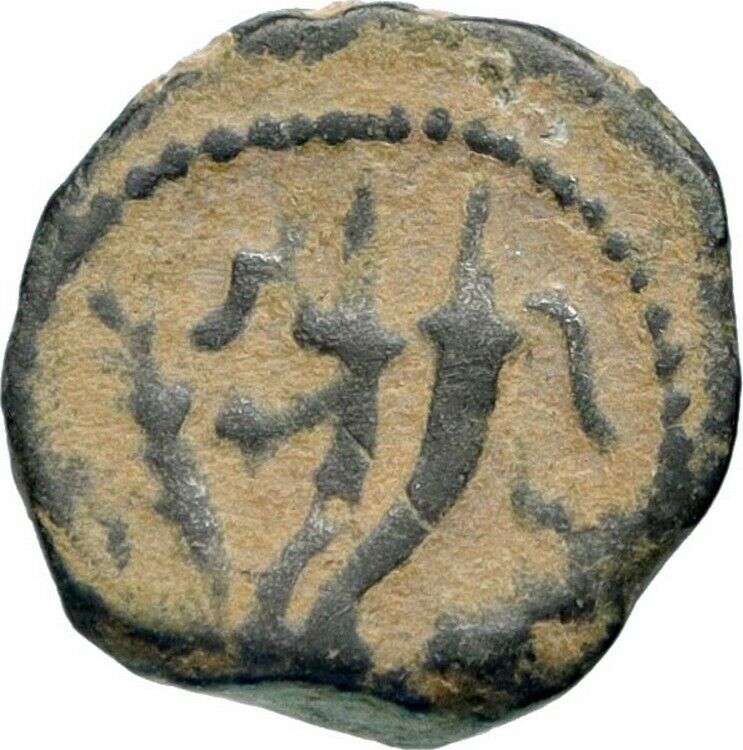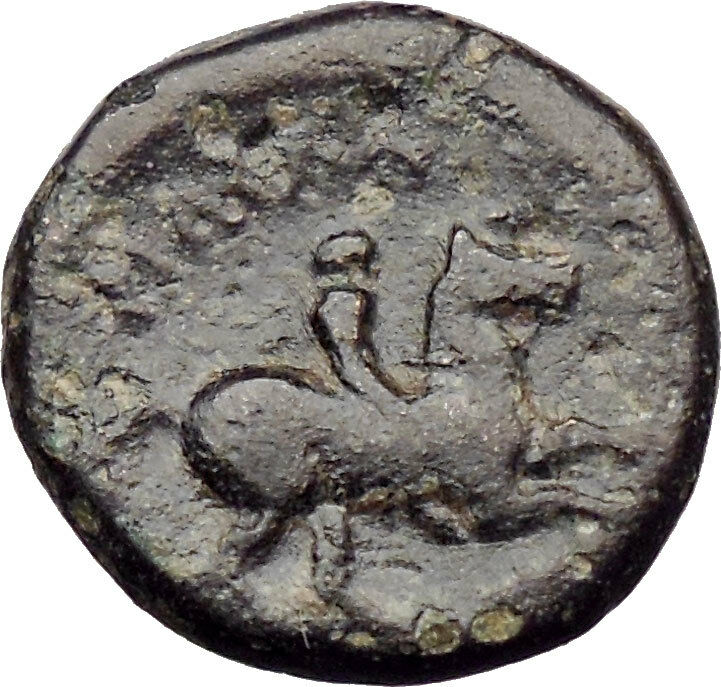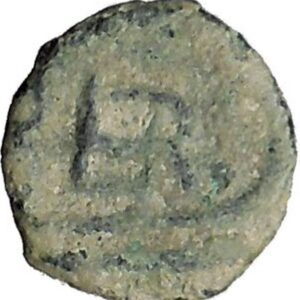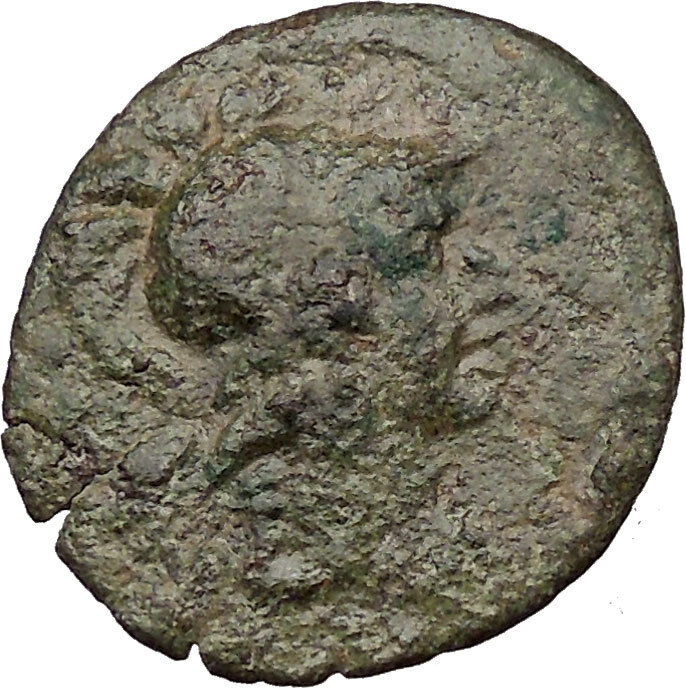|
GREEK City of
Pella
Macedonia
Bronze 19mm (3.63 grams) Struck 158-149 B.C.
Reference: Sear 1446; Moushmov 6453; SNGCop 266ff.
Helmeted head of
Athena
Parthenos right
ΠEΛ-ΛHΣ,
bull grazing right.
The city was founded by Archelaus I of Macedon (413–399 BC) as
the capital of his kingdom, replacing the older palace-city of Aigai (Vergina).
After this, it was the seat of King Philip II of Macedon and of Alexander the
Great, his son. In 168 BC, it was sacked by the Romans, and its treasury
transported to Rome. Later, the city was destroyed by an earthquake and
eventually was rebuilt over its ruins. By 180 AD, Lucian could describe it in
passing as “now insignificant, with very few inhabitants”.
You are bidding on the exact
item pictured, provided with a Certificate of Authenticity and Lifetime
Guarantee of Authenticity.
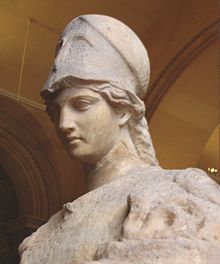
Helmeted Athena with the cista and Erichthonius in his serpent form.
Roman, first century (Louvre
Museum)
In
Greek religion
and
mythology
, Athena or Athene, also
referred to as Pallas Athena/Athene , is the goddess of wisdom, courage,
inspiration, civilization, law and justice, just warfare, mathematics, strength,
strategy, the arts, crafts, and skill.
Minerva
is the
Roman goddess
identified with
Athena.
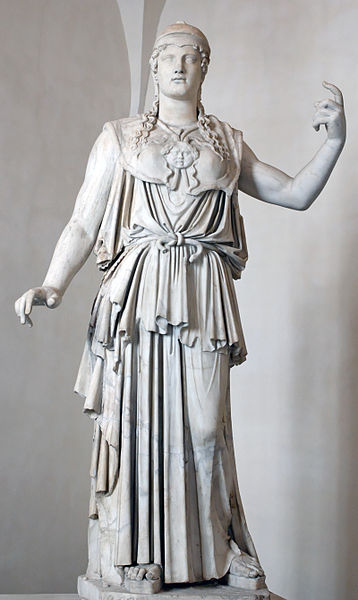
Athena is also a shrewd companion of
heroes and is the
goddess
of heroic endeavour. She is the
virgin
patroness of
Athens
. The Athenians founded the
Parthenon
on the Acropolis of her namesake
city, Athens (Athena Parthenos), in her honour.
Athena’s veneration as the patron of Athens seems to have existed from the
earliest times, and was so persistent that archaic myths about her were recast
to adapt to cultural changes. In her role as a protector of the city (polis),
many people throughout the Greek world worshiped Athena as Athena Polias
(Ἀθηνᾶ Πολιάς “Athena of the city”). The city of
Athens
and the goddess Athena essentially bear
the same name, “Athenai” meaning “[many] Athenas”.
Patroness
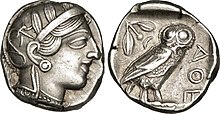
Athenian
tetradrachm
representing the
goddess Athena
Athena as the goddess of philosophy became an aspect of the cult in Classical
Greece during the late 5th century B.C. She is the patroness of various crafts,
especially of weaving
, as Athena Ergane, and was
honored as such at festivals such as
Chalceia
. The metalwork of weapons also fell
under her patronage. She led battles (Athena
Promachos or the warrior maiden Athena Parthenos) as the
disciplined, strategic side of war, in contrast to her brother
Ares, the patron of violence, bloodlust and slaughter—”the raw force
of war”. Athena’s wisdom includes the cunning intelligence (metis) of
such figures as Odysseus
. Not only was this version of Athena
the opposite of Ares in combat, it was also the polar opposite of the serene
earth goddess version of the deity, Athena Polias.
Athena appears in Greek mythology as the patron and helper of many heroes,
including Odysseus
,
Jason
, and
Heracles
. In
Classical Greek
myths, she never consorts with
a lover, nor does she ever marry,earning the title Athena Parthenos. A
remnant of archaic myth depicts her as the adoptive mother of
Erechtheus
/Erichthonius
through the foiled rape by
Hephaestus
. Other variants relate that
Erichthonius, the serpent that accompanied Athena, was born to
Gaia
: when the rape failed, the semen landed on
Gaia and impregnated her. After Erechthonius was born, Gaia gave him to Athena.
Though Athena is a goddess of war strategy, she disliked fighting without
purpose and preferred to use wisdom to settle predicaments.The goddess only
encouraged fighting for a reasonable cause or to resolve conflict. As patron of
Athens she fought in the Trojan war on the side of the Achaeans.
Mythology
Lady of Athens
Athena competed with
Poseidon
to be the patron deity of Athens,
which was yet unnamed, in a version of one
founding myth
. They agreed that each would give
the Athenians one gift and that the Athenians would choose the gift they
preferred. Poseidon struck the ground with his
trident
and a salt water spring sprang up; this
gave them a means of trade and water—Athens at its height was a significant sea
power, defeating the
Persian
fleet at the
Battle of Salamis
—but the water was salty and
not very good for drinking.
Athena, however, offered them the first domesticated
olive tree
. The Athenians (or their king,
Cecrops
) accepted the olive tree and with it
the patronage of Athena, for the olive tree brought wood, oil, and food.
Robert Graves
was of the opinion that
“Poseidon’s attempts to take possession of certain cities are political myths”
which reflect the conflict between matriarchal and patriarchal religions.
Other sites of cult
Athena also was the patron goddess of several other Greek cities, notably
Sparta, where the archaic cult of
Athena Alea
had its sanctuaries in the
surrounding villages of
Mantineia
and, notably,
Tegea
. In Sparta itself, the temple of Athena
Khalkíoikos (Athena “of the Brazen House”, often
latinized
as Chalcioecus) was the
grandest and located on the Spartan acropolis; presumably it had a roof of
bronze. The forecourt of the Brazen House was the place where the most solemn
religious functions in Sparta took place.
Tegea was an important religious center of ancient Greece, containing the
Temple of Athena Alea
. The temenos was founded by
Aleus
,
Pausanias
was informed. Votive bronzes at the
site from the Geometric and Archaic periods take the forms of horses and deer;
there are
sealstone
and
fibulae
. In the Archaic period the nine
villages that underlie Tegea banded together in a
synoecism
to form one city. Tegea was listed in
Homer
‘s
Catalogue of Ships
as one of the cities that
contributed ships and men for the
Achaean assault on Troy
.
Judgment of Paris

Aphrodite is being surveyed by Paris, while Athena (the leftmost
figure) and Hera stand nearby.
El Juicio de Paris
by
Enrique Simonet
, ca. 1904
All the gods and goddesses as well as various mortals were invited to the
marriage of Peleus
and
Thetis
(the eventual parents of
Achilles
). Only
Eris
, goddess of discord, was not invited. She
was annoyed at this, so she arrived with a golden apple inscribed with the word
καλλίστῃ (kallistēi, “for the fairest”), which she threw among the goddesses.
Aphrodite, Hera, and Athena all claimed to be the fairest, and thus the rightful
owner of the apple.
The goddesses chose to place the matter before Zeus, who, not wanting to
favor one of the goddesses, put the choice into the hands of Paris, a
Trojan prince. After bathing in the spring of
Mount Ida
(where Troy was situated), the
goddesses appeared before Paris. The goddesses undressed and presented
themselves to Paris naked, either at his request or for the sake of winning.

Paris is awarding the apple to Aphrodite, while Athena makes a face.
Urteil des Paris by
Anton Raphael Mengs
, ca. 1757
Still, Paris could not decide, as all three were ideally beautiful, so they
resorted to bribes. Hera tried to bribe Paris with control over all
Asia and Europe
, while Athena offered wisdom, fame and
glory in battle, but Aphrodite came forth and whispered to Paris that if he were
to choose her as the fairest he would have the most beautiful mortal woman in
the world as a wife, and he accordingly chose her. This woman was
Helen
, who was, unfortunately for Paris,
already married to King
Menelaus
of
Sparta
. The other two goddesses were enraged by
this and through Helen’s abduction by Paris they brought about the
Trojan War
.

The Parthenon
, Temple of Athena
Parthenos
Masculinity and
feminism
Athena had an “androgynous compromise” that allowed her traits and what she
stood for to be attributed to male and female rulers alike over the course of
history (such as Marie de’ Medici, Anne of Austria, Christina of Sweden, and
Catherine the Great)
J.J. Bachofen advocated that Athena was originally a maternal figure stable
in her security and poise but was caught up and perverted by a patriarchal
society; this was especially the case in Athens. The goddess adapted but could
very easily be seen as a god. He viewed it as “motherless paternity in the place
of fatherless maternity” where once altered, Athena’s character was to be
crystallized as that of a patriarch.
Whereas Bachofen saw the switch to paternity on Athena’s behalf as an
increase of power, Freud on the contrary perceived Athena as an “original mother
goddess divested of her power”. In this interpretation, Athena was demoted to be
only Zeus’s daughter, never allowed the expression of motherhood. Still more
different from Bachofen’s perspective is the lack of role permanency in Freud’s
view: Freud held that time and differing cultures would mold Athena to stand for
what was necessary to them.
Pella (Greek:
Πέλλα), an ancient city located in
Pella Prefecture
of
Macedonia
in Greece
, was the
capital
of the
ancient
kingdom
of
Macedon
. A common
folk etymology
is traditionally given for the name Pella, ascribing
it to a form akin to the
Doric
Apella
,
originally meaning a ceremonial location where decisions were made.[1]
However, the local form of Greek was not Doric, and the word exactly matches
standard Greek pélla “stone”, undoubtedly referring to a famous landmark
from the time of its foundation.
//
History
The city was founded by
Archelaus
(413–399
BC) as the capital of his kingdom, replacing the older palace-city of
Aigai
(Vergina).
After this, it was the seat of the king
Philip II
and of
Alexander
, his son. In
168 BC
, it was
sacked by the
Romans
,
and its treasury transported to
Rome. Later, the
city was destroyed by an
earthquake
and eventually was rebuilt over its ruins. By 180 AD,
Lucian
could
describe it in passing as “now insignificant, with very few inhabitants”.
Pella is first mentioned by
Herodotus
of
Halicarnassus
(VII, 123) in relation to
Xerxes
‘ campaign and by
Thucydides
(II, 99,4 and 100,4) in relation to Macedonian expansion and the war against
Sitalces
,
the king of the Thracians
. According to
Xenophon
,
in the beginning of the 4th century BC, it was the largest Macedonian city. It
was probably built as the capital of the kingdom by Archelaus, although there
appears to be some possibility that it may have been
Amyntas
. It attracted Greek artists such the painter
Zeuxis
, the poet
Timotheus
of
Miletus
and the
tragic author
Euripides
who finishes his days there writing and producing Archelaus.
Archelaus invited the painter
Zeuxis
, the
greatest painter of the time, to decorate it. He was later the host of the
Athenian playwright
Euripides
in his retirement. Euripides
Bacchae
premiered here, about
408 BC
. Pella
was the birthplace of Philip II and of Alexander, his son. The hilltop
palace
of
Philip, where Aristotle
tutored young Alexander, is being excavated.
In antiquity, Pella was a port connected to the
Thermaic Gulf
by a navigable
inlet
, but the
harbor has silted, leaving the site landlocked. The reign of
Antigonus
likely represented the height of the city, as this is the period
which has left us the most archaeological remains.
Pella is further mentioned by
Polybius
and Livy
as the
capital of
Philip V
and of
Perseus
during the
Macedonian Wars
, fought against the
Roman Republic
. In the writings of Livy, we find the only description of how
the city looked in 167 BC
to
Lucius Aemilius Paulus Macedonicus
, the Roman who defeated Perseus at the
battle
of Pydna
:
- …[Paulus] observed that it was not without good reason that it had been
chosen as the royal residence. It is situated on the south-west slope of a
hill and surrounded by a marsh too deep to be crossed on foot either in
summer or winter. The citadel the “Phacus,” which is close to the city,
stands in the marsh itself, projecting like an island, and is built on a
huge substructure which is strong enough to carry a wall and prevent any
damage from the infiltration from the water of the lagoon. At a distance it
appears to be continuous with the city wall, but it is really separated by a
channel which flows between the two walls and is connected with the city by
a bridge. Thus it cuts off all means of access from an external foe, and if
the king shut anyone up there, there could be no possibility of escape
except by the bridge, which could be very easily guarded..[3]
The famous poet Aratus
died in Pella ca
240 BC
. Pella
was sacked by the Romans in
168 BC
, when
its treasury was transported to Rome.
In the
Roman province of Macedonia
, Pella was the capital of the third district,
and was possibly the seat of the Roman governor. Crossed by the
Via
Egnatia
[4],
Pella remained a significant point on the route between
Dyrrachium
and
Thessalonika
. Cicero
stayed there in
58 BC
, but by
then the provincial seat had already transferred to Thessalonika. It was then
destroyed by earthquake in the first century BC; shops and workshops dating from
the catastrophe have been found with remains of their merchandise. The city was
eventually rebuilt over its ruins, which preserved them, but, ca
AD 180
,
Lucian
of Samosata
could describe it in passing as “now insignificant, with very few
inhabitants”
[5]
The city went into decline for reasons unknown (possibly an earthquake) by
the end of the 1st century BC. It was the object of a colonial deduction
sometime between 45 and
30 BC
; in any
case currency was marked Colonia Iulia Augusta Pella.
Augustus
settled peasants there whose land he had usurped to give to his veterans (Dio
Cassius LI, 4). But unlike other Macedonian colonies such as
Philippi
,
Dion
, and
Cassandreia
it never came under the jurisdiction of
ius
Italicum
or Roman law. Four pairs of colonial magistrates (IIvirs
quinquennales) are known for this period.
The decline of the city was rapid, in spite of colonization:
Dio
Chrysostom
( 33.27Or.)
and Lucian
both
attest to the ruin of the ancient capital of Philip II and Alexander; though
their accounts may be exaggerated. In fact, the Roman city was somewhat to the
west of and distinct from the original capital; which explains some
contradictions between coinage,
epigraphs
, and testimonial accounts. In the Byzantine period, the Roman site
was occupied by a fortified village.
The
site
Urban
area
The city is built on the
island
of Phacos
, a
promontory
which dominates the wetlands which encircle Pella to the south, and a lake which
opened to the sea in the
Hellenistic period
.
Palace
The city wall mentioned by Livy is only partly known. It consists of a
rampart of crude bricks (about 50 cm square) raised on a stone foundation; some
of which has been located North of the palace, and some in the South next to the
lake. Inside the ramparts, three hills occupy the North, and the palace is
situated on a place of honour on the central hill. Partly searched, it occupied
a considerable area of perhaps 60,000 square metres). The plan is still not well
known, but has been related to that of the city plan (see diagram).
The Pella palace consisted of several — possibly seven — large architectural
groupings juxtaposed in two rows, each including a series of rooms arranged
around a central square courtyard, generally with porticos. Archaeologists have
thus far identified a
palaestra
and baths
. The south facade of the palace, towards the city, consisted of one
large (at least 153 metres long) portico, constructed on a two metres high
foundation. The relationship between the four principal complexes is defined by
an interruption in the portico occuupied by a triple
propylaeum
, 15 m high, which gave the palace an imposing monumental air when
seen from the city below.
Dating of the palace has posed some problems: the large buildings could date
the reign of Philip II, but other buildings appear to be earlier. The baths date
from the reign of
Cassander
.
The size of the complex indicates that, unlike the palace at Vergina, this
was not only a royal residence or a grandiose monument but also a place of
government which was required to accommodate a portion of the administrative
apparatus of the kingdom.
Hippodamean
plan
The city proper was located south of and below the palace. Designed on a
grid plan
as envisaged by
Hippodamus
, it consists of two series of parallel streets which intersect at
right angles and form a grid of eight rows of rectangular blocks. These blocks
are of a consistent width — each approximately 45 m — and a length which varies
from 111 m to 152 m, 125 metres being the most common. The streets are from 9 to
10 metres wide, except for the middle East–West arterial, which is up to 15
metres wide. This street is the primary access to the central public
agora
, which
occupied a space of ten blocks. Two North-South streets area also a bit wider
than the rest, and serve to connect the city to the port further South. The
streets had sewers and were equipped to convey water to individual residences.

Lion Hunt Mosaic in Pella
This type of plan dates to the first half of the fourth century BC, and is
very close to the ideal in design, though it distinguishes itself by large block
size; Olynthus
in
Chalcidice
for example had blocks of 86.3×35 metres. On the other hand,
later Hellenistic urban foundations have blocks comparable to those of Pella:
112×58 m in Laodicea ad Mare
, or 120×46 m in
Aleppo
.
The agora holds pride of place in the centre of the city, occupying an
imposing 200 by 181 metres; 262×238 metres if one counts the potrticos which
surround it on all sides.
Archaeology
Based on the descriptions provided by
Titus Livius
, the site was explored by 19th-century voyagers including
Holand, Pouqueville, Beaujour, Cousinéry, Delacoulonche, Hahn, Glotz and Struck.
The first excavation was begun by G. Oikonomos in 1914–15. The modern systematic
exploration of the site began in 1953 and full excavation was being done in
1957. The first series of campaigns were completed in 1963, more excavations
following in 1980. These digs continue in the section identified as the agora.
In February 2006, a farmer accidentally uncovered the largest tomb ever found
in Greece. The names of the noble
ancient Macedonian
family are still on inscriptions and painted sculptures
and walls have survived. The tomb dates to the
2nd
or 3rd century BC, following the rule of Alexander the Great.[6]
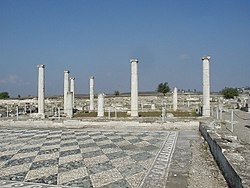
An atrium with a pebble-mosaic paving
Archaeological digs in progress since 1957 have uncovered a small part of the
city, which was made rich by Alexander and his heirs. The large agora or market
was surrounded by the shaded colonnades of
stoae, and streets
of enclosed houses with frescoed walls round inner courtyards. The first
trompe-l’oeil
wall murals imitating perspective views ever seen were on
walls at Pella. There are
temples
to Aphrodite
,
Demeter
and
Cybele
, and
Pella’s pebble-mosaic floors, dating after the lifetime of Alexander, are
famous: some reproduce Greek paintings; one shows a lion-griffin attacking a
stag, a familiar motif also of
Scythian
art, another depicts
Dionysus
riding a leopard.
Macedonia or Macedon (from
Greek
: Μακεδονία,
Makedonía) was an
ancient kingdom
, centered in the northeastern part of
the
Greek peninsula
,
bordered by
Epirus
to the west,
Paionia
to the north, the region of
Thrace
to the east and
Thessaly
to the south. For a brief period,
after the conquests of
Alexander the Great
, it became the most
powerful state in the world, controlling a territory that included most of
Greece
and
Persia
, stretching as far as the
Indus River
; at that time it inaugurated the
Hellenistic period
of
history
.
Name
The name Macedonia (Greek:
Μακεδονία,
Makedonía) is related to
the ancient Greek word μακεδνός (Makednos).
It is commonly explained as having originally meant ‘a tall one’ or
‘highlander’, possibly descriptive of the
people
. The shorter English name variant
Macedon developed in Middle English, based on a borrowing from the French
form of the name, Macédoine.
History
Early history and
legend
The lands around Aegae, the first Macedonian capital, were home to various
peoples. Macedonia was called Emathia (from king Emathion) and the city of Aiges
was called Edessa, the capital of fabled king Midas. According to legend,
Caranus, accompanied by a multitude of Greeks came to the area in search for a
new homeland
[5]
took Edessa and renamed it to Aegae.
Subsequently, he expelled Midas and other kings off the lands and he formed his
new kingdom. According to Herodot, it was Dorus, the son of Hellen who led his
people to Histaeotis, whence they were driven off by the Cadmeians into Pindus,
where they settled as Macedonians. Later, a branch would migrate further south
to be called Dorians
[6]
.
It seems that the first
Macedonian
state emerged in the
8th
or early
7th century BC
under the
Argead Dynasty
, who, according to legend,
migrated to the region from the
Greek city
of
Argos
in Peloponnesus (thus the name Argead).[7]
It should be mentioned that the Macedonian tribe ruled by the Argeads, was
itself called Argead (which translates as “descended from Argos”).
The kingdom was situated in the fertile alluvial plain, watered by the rivers
Haliacmon
and
Axius
, called Lower Macedonia, north of
the mountain
Olympus
. Around the time of
Alexander I of Macedon
, the Argead Macedonians
started to expand into
Upper Macedonia
, lands inhabited by independent
Macedonian tribes like the Lyncestae and the Elmiotae and to the West, beyond
Axius river, into
Eordaia
,
Bottiaea
,
Mygdonia
, and
Almopia
-, regions settled by, among others,
many Thracian tribes.[8]
Near the modern city of
Veria
,
Perdiccas I
(or, more likely, his son,
Argaeus I
) built his capital, Aigai (modern
Vergina
). After a brief period under
Persian
rule under
Darius Hystaspes
, the state regained its
independence under King
Alexander II
(495–450
BC).

Macedon during the
Peloponnesian Warr
around 431 BC.
In the long
Peloponnesian War
Macedon was a secondary power
that alternated in support between Sparta and Athens.
Involvement in
the Greek world
Prior to the
4th century BC
, the kingdom covered a region
approximately corresponding to the
province of Macedonia
of modern
Greece Amyntas III
(c.
393
–370
BC), though it still retained strong contrasts between the
cattle-rich coastal plain and the fierce isolated tribal hinterland, allied to
the king by marriage ties. They controlled the passes through which barbarian
invasions came from
Illyria
to the north and northwest. It became
increasingly
Atticised
during this period, though prominent
Athenians
appear to have regarded the
Macedonians as uncouth.[10]
Before the establishment of the
League of Corinth
, even though the Macedonians
apparently spoke a dialect of the Greek language and claimed proudly that they
were Greeks, they were not considered to fully share the
classical Greek
culture by many of the
inhabitants of the southern city states, because they did not share the
polis
based style of government of the
southerners.[9]
Herodotus
, being one of the foremost biographer
in antiquity who lived in Greece at the time when the Macedonian king
Alexander I
was in power, mentioned: “I
happen to know, and I will demonstrate in a subsequent chapter of this history,
that these descendants of Perdiccas are, as they themselves claim, of Greek
nationality. This was, moreover, recognized by the managers of the
Olympic games
, on the occasion when
Alexander
wished to compete and his Greek
competitors tried to exclude him on the ground that foreigners were not allowed
to take part. Alexander, however, proved his Argive descent, and so was accepted
as a Greek and allowed to enter for the foot-race. He came in equal first”..[11]
Over the 4th century Macedon became more politically involved with the
south-central city-states of
Ancient GreecePella
, resembling
Mycenaean
culture more than classic
Hellenic
city-states, and other archaic
customs, like Philip’s multiple wives in addition to his Epirote queen
Olympias
, mother of Alexander.
Another archaic remnant was the very persistence of a
hereditary
monarchy
which wielded formidable – sometimes
absolute – power, although this was at times checked by the landed aristocracy,
and often disturbed by power struggles within the royal family itself. This
contrasted sharply with the Greek cultures further south, where the ubiquitous
city-states mostly possessed aristocratic or democratic institutions; the
de facto
monarchy of
tyrants
, in which heredity was usually more of
an ambition rather than the accepted rule; and the limited, predominantly
military and sacerdotal, power of the twin hereditary
Spartan
kings. The same might have held true of
feudal
institutions like
serfdom
, which may have persisted in Macedon
well into historical times. Such institutions were abolished by city-states well
before Macedon’s rise (most notably by the Athenian legislator
Solon
‘s famous
σεισάχθεια
seisachtheia
laws)..
Amyntas had three sons; the first two,
Alexander II
and
Perdiccas III
reigned only briefly. Perdiccas
III’s infant heir was deposed by Amyntas’ third son,
Philip II of Macedon
, who made himself king and
ushered in a period of Macedonian dominance of Greece. Under Philip II, (359–336
BC), Macedon expanded into the territory of the
Paionians
,
Thracians
, and
Illyrians
. Among other conquests, he annexed
the regions of
Pelagonia
and Southern
Paionia
.[12]]

Kingdom of Macedon after Philip’s II death.
Philip redesigned the
army of Macedon
adding a number of variations
to the traditional
hoplite
hetairoi
, a well armoured heavy cavalry, and
more light infantry, both of which added greater flexibility and responsiveness
to the force. He also lengthened the spear and shrank the shield of the main
infantry force, increasing its offensive capabilities.
Philip began to rapidly expand the borders of his kingdom. He first
campaigned in the north against non-Greek peoples such as the
IllyriansAmphipolis
, which controlled the way
into Thracee
and also was near valuable silver
mines. This region had been part of the
Athenian Empire
, and Athens still considered it
as in their sphere. The Athenians attempted to curb the growing power of
Macedonia, but were limited by the outbreak of the
Social War
. They could also do little to halt
Philip when he turned his armies south and took over most of
Thessaly
.
Control of Thessaly meant Philip was now closely involved in the politics of
central Greece. 356 BCE saw the outbreak of the
Third Sacred War
that pitted
Phocis
against
Thebes
and its allies. Thebes recruited the
Macedonians to join them and at the
Battle of Crocus Field
Phillip decisively
defeated Phocis and its Athenian allies. As a result Macedonia became the
leading state in the
Amphictyonic League
and Phillip became head of
the Pythian Games, firmly putting the Macedonian leader at the centre of the
Greek political world.
In the continuing conflict with Athens Philip marched east through Thrace in
an attempt to capture
Byzantium
and the
Bosphorus
, thus cutting off the Black Sea grain
supply that provided Athens with much of its food. The siege of Byzantium
failed, but Athens realized the grave danger the rise of Macedon presented and
under Demosthenes
built a coalition of many of the
major states to oppose the Macedonians. Most importantly Thebes, which had the
strongest ground force of any of the city states, joined the effort. The allies
met the Macedonians at the
Battle of Chaeronea
and were decisively
defeated, leaving Philip and the Macedonians the unquestioned master of Greece.
Empire
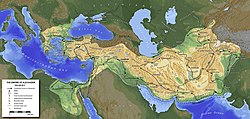
Alexander’s empire at the time of its maximum expansion
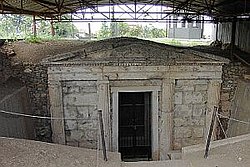
The entrance to one of the royal tombs at Vergina, a UNESCO World
Heritage site.
Philip’s son,
Alexander the Great
(356–323
BC), managed to briefly extend Macedonian power not only over the
central Greek city-states, but also to the
Persian empire
, including
Egypt
and lands as far east as the fringes of
India
. Alexander’s adoption of the styles of
government of the conquered territories was accompanied by the spread of Greek
culture and learning through his vast empire. Although the empire fractured into
multiple Hellenic regimes shortly after his death, his conquests left a lasting
legacy, not least in the new Greek-speaking cities founded across Persia’s
western territories, heralding the
Hellenistic
Diadochi, Macedonia fell to the
Antipatrid dynasty
, which was overthrown by the
Antigonid dynasty
after only a few years, in
294 BC..
Hellenistic era
Antipater
and his son
Cassander
gained control of Macedonia but it
slid into a long period of civil strife following Cassander’s death in
297 BC
. It was ruled for a while by
Demetrius I
(294–288
BC) but fell into civil war.
Demetrius’ son,
Antigonus II
(277–239
BC), defeated a
Galatian
invasion as a
condottiere
, and regained his family’s
position in Macedonia; he successfully restored order and prosperity there,
though he lost control of many of the Greek city-states. He established a stable
monarchy under the
Antigonid dynasty
.
Antigonus III
((239–221
BC) built on these gains by re-establishing Macedonian power across
the region.
What is notable about the Macedonian regime during the Hellenistic times is
that it was the only successor state to the Empire that maintained the old
archaic perception of Kingship, and never adopted the ways of the Hellenistic
Monarchy. Thus the king was never deified in the same way that Ptolemies and
Seleucids were in Egypt and Asia respectively, and never adopted the custom of
Proskynesis
. The ancient Macedonians during the
Hellenistic times were still addressing their kings in a far more casual way
than the subjects of the rest of the Diadochi, and the Kings were still
consulting with their aristocracy (Philoi) in the process of making their
decisions.
Conflict with Rome

Kingdom of Macedon under Philip V.
Under
Philip V of Macedon
(221–179
BC Perseus of Macedon (179–168
BC), the kingdom clashed with the rising power of the
Roman Republic
. During the
2nd
and
1st centuries BC
, Macedon fought a
series of wars
with Rome. Two major losses that
led to their inevitable defeat were in
197 BC
when Rome defeated Philip V, and
168 BC
when Rome defeated Perseus. The overall
losses resulted in the defeat of Macedon, the deposition of the Antigonid
dynasty and the dismantling of the Macedonian kingdom.
Andriscus
‘ brief success at reestablishing the
monarchy in 149 BCC
was quickly followed by his defeat the
following year and the establishment of direct
Roman
rule and the organization of Macedon as
the
Roman province of Macedonia
.
Institutions
éthnē), and between the two, the districts. The study of these different
institutions has been considerably renewed thanks to
epigraphy
, which has given us the possibility
to reread the indications given us by ancient literary sources such as
Livy and
Polybius
. They show that the Macedonian
institutions were near to those of the Greek federal states, like the
Aetolian
and
Achaeann
leagues, whose unity was reinforced by
the presence of the king.

The
Vergina Sun
, the 16-ray star covering
what appears to be the royal burial larnax of Philip II of Macedon,
discovered in Vergina, Greece.
The King
The king
Βασιλεύς,
Basileús) headed the
central administration: he led the kingdom from its capital, Pella, and in his
royal palace was conserved the state’s archive. He was helped in carrying out
his work by the Royal Secretary (βασιλικὸς
γραμματεύς, basilikós
grammateús), whose work was of primary importance, and by the
Council
.
The king was commander of the army, head of the Macedonian religion, and
director of diplomacy. Also, only he could conclude treaties, and, until
Philip V
, mint coins.
The number of civil servants was limited: the king directed his kingdom
mostly in an indirect way, supporting himself principally through the local
magistrates, the epistates, with whom he constantly kept in touch.
Successionon
Royal succession in Macedon was hereditary, male,
patrilineal
and generally respected the
principle of
primogeniture
. There was also an elective
element: when the king died, his designated heir, generally but not always the
eldest son, had first to be accepted by the council and then presented to the
general Assembly to be acclaimed king and obtain the oath of fidelity.
Perdiccas III, slain by the
Illyrians
,
Philip II
assassinated by
Pausanias of Orestis
,
Alexander the Great
, suddenly died of malady,
etc. Succession crises were frequent, especially up to the
4th century BC
, when the magnate families of
Upper Macedonia still cultivated the ambition of overthrowing the Argaead
dynasty and to ascend to the throne.

An atrium with a pebble-mosaic paving, in Pella, Greece
Financesces
The king was the simple guardian and administrator of the treasure of Macedon
and of the king’s incomes (βασιλικά,
basiliká), which belonged
to the Macedonians: and the tributes that came to the kingdom thanks to the
treaties with the defeated people also went to the Macedonian people, and not to
the king. Even if the king was not accountable for his management of the
kingdom’s entries, he may have felt responsible to defend his administration on
certain occasions: Arrian
tells us that during the
mutiny
of Alexander’s soldiers at
Opis in 324 BC BC
, Alexander detailed the possessions
of his father at his death to prove he had not abused his charge.
It is known from Livy and Polybius that the basiliká included the
following sources of income:
- The mines of gold and silver (for example those of the
Pangaeus
), which were the exclusive
possession of the king, and which permitted him to strike currency, as
already said his sole privilege till Philip V, who conceded to cities and
districts the right of coinage for the lesser denominations, like bronze.
- The forests, whose timber was very appreciated by the Greek
cities to build their ships: in particular, it is known that
Athens
made commercial treaties with
Macedon in the
5th century BC
to import the timber
necessary for the construction and the maintenance of its fleet of war.
- The royal landed properties, lands that were annexed to the royal
domain through conquest, and that the king exploited either directly, in
particular through servile workforce made up of prisoners of war, or
indirectly through a leasing system.
- The port duties on commerce (importation and exportation taxes).
The most common way to exploit these different sources of income was by
leasing: the Pseudo-Aristotle
reports in the
Oeconomica
that
Amyntas III
(or maybe Philip II) doubled the
kingdom’s port revenues with the help of
Callistratus
, who had taken refuge in Macedon,
bringing them from 20 to 40
talents
per year. To do this, the exploitation
of the harbour taxes was given every year at the private offering the highest
bidding. It is also known from Livy that the mines and the forests were leased
for a fixed sum under Philip V, and it appears that the same happened under the
Argaead dynasty: from here possibly comes the leasing system that was used in
Ptolemaic Egypt
.
Except for the king’s properties, land in Macedon was free: Macedonians were
free men and did not pay land taxes on private grounds. Even extraordinary taxes
like those paid by the Athenians in times of war did not exist. Even in
conditions of economic peril, like what happened to Alexander in
334 BC< and Perseus in
168 BC
, the monarchy did not tax its subjects
but raised funds through loans, first of all by his Companions, or raised the
cost of the leases.
The king could grant the atelíē (ἀτελίη),
a privilege of tax exemption, as Alexander did with those Macedonian families
which had losses in the
battle of the Granicus
in May
334334
: they were exempted from paying tribute
for leasing royal grounds and commercial taxes.
Extraordinary incomes came from the spoils of war, which were divided between
the king and his men. At the time of Philip II and Alexander, this was a
considerable source of income. A considerable part of the gold and silver
objects taken at the time of the European and Asian campaigns were melted in
ingots and then sent to the monetary foundries of
Pella
Amphipolis, most active of the kingdom at
that time: an estimate judges that during the reign of Alexander only the mint
of Amphipolis struck about 13 million silver
tetradrachms
.
The Assembly
All the kingdom’s citizen-soldiers gather in a popular assembly, which is
held at least twice a year, in spring and in autumn, with the opening and the
closing of the campaigning season.
This assembly (koinê ekklesia
or koinon makedonôn), of
the army in times of war, of the people in times of peace, is called by the king
and plays a significant role through the acclamation of the kings and in capital
trials; it can be consulted (without obligation) for the foreign politics
(declarations of war, treaties) and for the appointment of high state officials.
In the majority of these occasions, the Assembly does nothing but ratify the
proposals of a smaller body, the Council. It is also the Assembly which votes
the honors, sends embassies, during its two annual meetings. It was abolished by
the Romans
at the time of their reorganization of
Macedonia in 167 BC
, to prevent, according to
Livy, that a demagogue could make use of it as a mean to revolt
against their authority.
The Friends (philoi)
or the king’s Companions (basilikoi
hetairoi
) were named for life by the king
among the Macedonian aristocracy.cy.
The most important generals of the army (hégémones
tôn taxéôn), also named by the king.
The king had in reality less power in the choice of the members of the
Council than appearances would warrant; this was because many of the kingdom’s
most important noblemen were members of the Council by birth-right.
The Council primarily exerted a probouleutic function with respect to the
Assembly: it prepared and proposed the decisions which the Assembly would have
discussed and voted, working in many fields such as the designation of kings and
regents, as of that of the high administrators and the declarations of war. It
was also the first and final authority for all the cases which did not involve
capital punishment.
The Council gathered frequently and represented the principal body of
government of the kingdom. Any important decision taken by the king was
subjected before it for deliberation.on.
Inside the Council ruled the democratic principles of iségoria
(equality of word) and of parrhésia (freedom of speech), to which even
the king subjected himself.
After the removal of the
Antigonid dynasty
by the Romans in
167 BC
, it is possible that the synedrion
remained, unlike the Assembly, representing the sole federal authority in
Macedonia after the country’s division in four merides.
Regional
districts (Merides)
The creation of an intermediate territorial administrative level between the
central government and the cities should probably be attributed to Philip II:
this reform corresponded with the need to adapt the kingdom’s institutions to
the great expansion of Macedon under his rule. It was no longer practical to
convene all the Macedonians in a single general assembly, and the answer to this
problem was the creation of four regional districts, each with a regional
assembly. These territorial divisions clearly did not follow any historical or
traditional internal divisions; they were simply artificial administrative
lines.
This said, it should be noted that the existence of
these districts is not attested with certainty (by
numismatics
) before the beginning of the
2nd century BC
.
|



















